History of Rowing Victoria Inc
- Table of Contents
- Introduction
- Chapters
- 1: Rowing in a young Victoria 1838-1859
- 2: Formation of the Association 1860-1875
- 3: Growth of the Sport 1876-1889
- 4: Years of great success 1890-1899
- 5: The rise of Australian Henley1900-1909
- 6: The War Years 1910-1919
- 7: Women's rowing and the modern era 1920-1929
- 8: The Depression Rebuild 1930-1939
- 9: War and rebuilding 1940-1949
- 10: Expansion years 1950-1959
- 11: The search for international success 1960-1969
- 12: Combining the Associations and lightweight success 1970-1979
- 13: The new national program 1980-1989
- 14: Golden years 1990-1999
- 15: Professionalism 2000-2009
- 16: Yet More Growth 2010-2019
- 17: Challenging Times 2020-2026
- Appendices
- 1: Life Membership and other important awards
- 2: Patrons and Presidents
- 3: Office Bearers
- 4: Clubs and their histories
- 5: The Oarsmen's Centotaph and WWI Roll of Honour
- 6: WWII Roll of Honour
- 7: Premierships
- 8: State Championships
- 9: Hall of Fame Inductees
- 10: Victorian Olympians
- 11: International representation
- 12: Intercolonial and Interstate Racing
- 13: School rowing
- 14: University rowing
- 15: Histories of Victorian Rowing
- 16: Annual Reports
5. The rise of Australian Henley (1900-1909)
Chapter 5 page 1 2 3 4
Victoria in the 1900s was a different place than in the previous decade. Firstly there was federation of the States in 1901 and many changes to avoid the civil disputes and strikes that lead to the depression and downturn of the 1890s.
Victoria became the temporary capital of the newly federated nation, with Melbourne home to many parliamentary establishments. The first Federal Parliament was opened in Melbourne’s (Royal) Exhibition Building in 1901 by the Duke and Duchess of Cornwall and York, and the first sitting of the High Court of Australia took place in the Banco Court of Melbourne’s Supreme Court building in 1903.
On the Victorian rowing scene, Victoria was very successful at the newly named Interstate Championships, and in 1904, the Australian Henley regatta commenced, a regatta which would play a significant part in Victorian sporting history. It was period of both stability and growth in the sport. The buds of women's rowing were formed and they blossomed post war. Specifically the first women's rowing club was formed on Albert Park Lake in 1907 led by Cassie Wooley.
1899-00 season
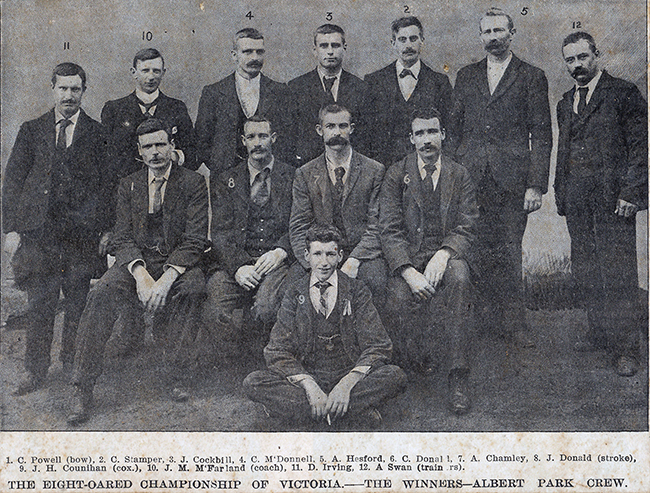
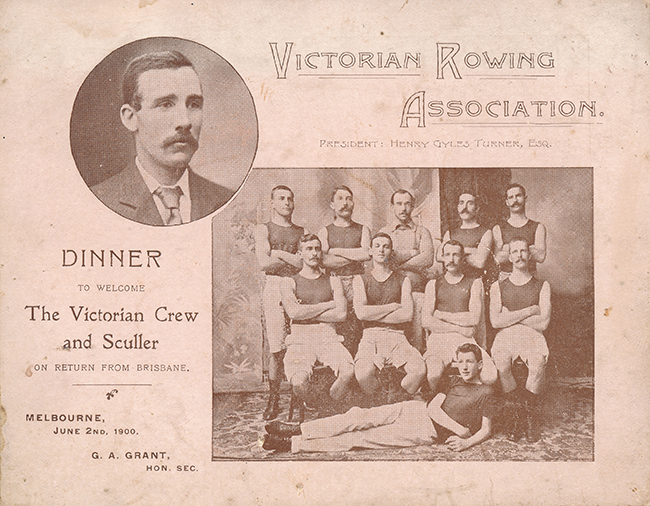
1900-01 season
Interstate Championships
Another good years for Victoria with a fine win in the eight oared championships of Australia. The crew comprised: Bow: Percy C Ivens, 2: J A Williams, 3: John Cockbill, 4: James Donald, 5: Alex Chamley, 6: William Potter, 7: Jack Southern, Str: Alex B Sloan, Cox: Lisle Jones, Cch: Jim M Macfarlane. No sculling representative was sent.
This season incorporated the federation of the States into the Commonwealth of Australia. Melbourne was the centre of those celebrations. The new Parliament sat in Victoria and the Governor General supported a Federation Regatta held on Albert Park Lake in May 1901. At that regatta, a famous sculling race took place which was the first recorded interstate women's rowing competition.1 Cassie McRitchie nee Wooley, used a skiff loaned to her by the then Governor of Victoria, Lord Brassey, and she was presented with a magnificent pearl and ruby bracelet by the Duke of Gloucester. So great was the public interest in the female scullers that police were required to keep the inquisitive spectators at bay. At the great age of 96 she passed away in 1973, and will for all time be remembered as the founder of the first all women's rowing club at Albert Park in 1907. Cassie McRitchie is justifiably known as the "mother" of Victorian women's rowing.
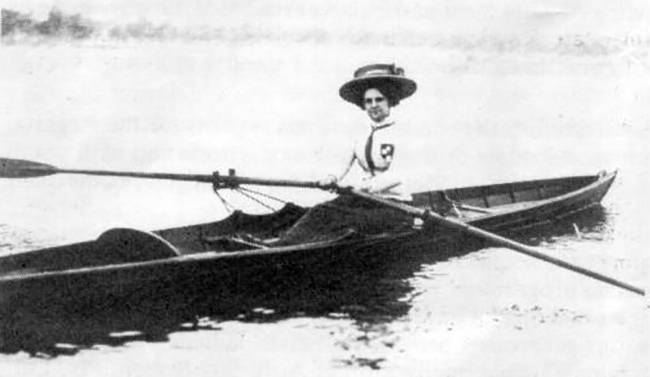
Cassie Wooley at the Federation Regatta on Albert Park Lake in May 1901
The newspaper Leader reported on the annual general meeting of the Victorian Rowing Association and highlighted two matters, both financial. The first was that the Association's finances were in a sound condition but [A]t no distant date one question must arise, viz., the raising of funds to meet the expenses incurred by Victoria being represented annually in the inter-State eight and four oared races. Either the rowing clubs must provide these funds or some method must be devised, by which public support shall be obtained. It is not enough to say that rowing as a pure sport and exercise should receive public assistance so far as having the State properly and regularly represented. Year after year the association has had to rely, mainly upon the club subscriptions and the help of a few gentlemen, oarsmen of from 20 to 30 years ago, who have contributed regularly to the expenses of sending Victorian crews to the other States. The number of these gentlemen is diminishing, not increasing, and something is needed to supplement their assistance.
The Leader also mentioned that the new pair oared championship received good support and it was acknowledged that Mercantile had a great season and was the premiership club for the season.
Victorian Championships
Mercantile won the inaugural pair oared championship, and also the four and eight oared championships. Charles Donald of of Albert Park was a 2 length winner of the sculling championship from Percy Ivens of Mercantile.
1901-02 season
Interstate Championships
Another great season for Victoria at the Interstate Championships with a fine win in the eight. The crew comprised: Bow: Percy C Ivens, 2: C E Suffren, 3: J A Williams, 4: Charles Donald, 5: Dr M K Moss, 6: Alex B Sloan, 7: Eric W Tulloch, Str: James Donald, Cox: J H Counihan, Cch: Jim M Macfarlane. The selectors were the coach and Mr A J Shepherd. Victoria was not represented in the sculling championship.
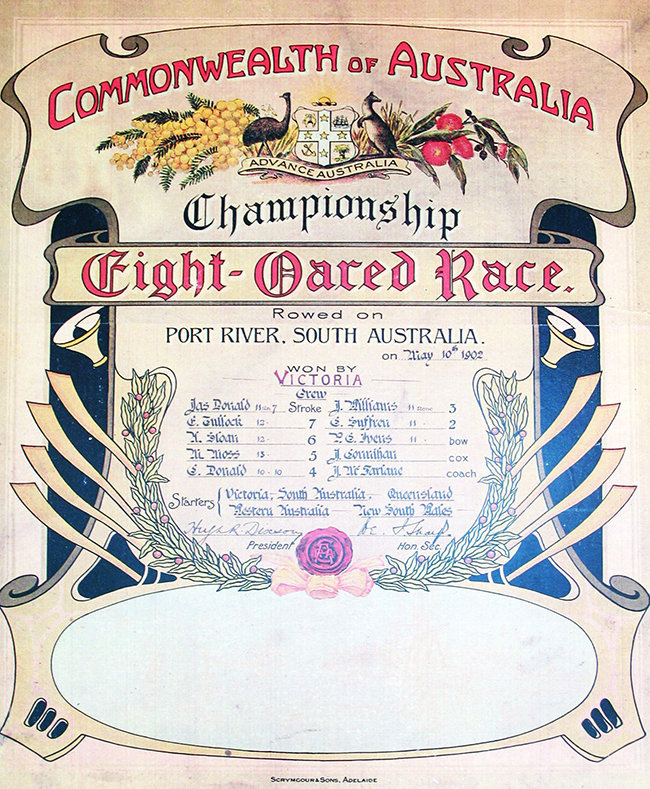
The winning crews pre WWI received a certificate from the host association for taking home the interstate championship.
Victorian Championships
The tables were turned this season with Albert Park Rowing Club again coming to the fore ahead of Mercantile. Albert Park won both the Pair and eight oared championships with Mercantile taking the sculling and four oared championships. After taking into account the many race wins for the year, Albert Park easily won the premiership from Mercantile.
Some extracts from the Victorian Rowing Association annual report.
The banks of the Upper Yarra were ablaze with enthusiastic spectators eager to witness the best combination eight racing that Victorian oarsmen could offer as the season began in October. It was ample preparation for the rowing gentlemen who would go on to compete fiercely in the various regattas held in Victoria that year, at Nagambie, Barwon, Ballarat and Rutherglen to name but a few.
As the competition drew to a close, Albert Park would emerge victorious in the battle for the Premiership, and in doing so win the Championship Eight Pennant.
The Interstate Eight-Oared Race was contested in Adelaide this year, and resulted in yet another fine victory for the dominant Victorian eight. To assist the Inter-State Eight, funds were raised at a Theatre party at Her Majesty’s Theatre in April.
The Annual Dinner of the Association was held at the Vienna Café in June and proved to be a very enjoyable function for all who attended.
1903 season
Interstate Championships
Another successful regatta for Victoria winning convincingly the eight oared championship for the tenth time in succession. The crew was comprised of: bow: J A Williams, 2: F Bainbridge, 3: R W May, 4: M G Scott, 5: Eric W Tulloch, 6: Charles Donald, 7: Alex Chamley, Str: James Donald, Cox/Cch: Jim M Macfarlane. The crew was selected by Arthur J Shepherd, Edward R Ainley & Jim M Macfarlane.
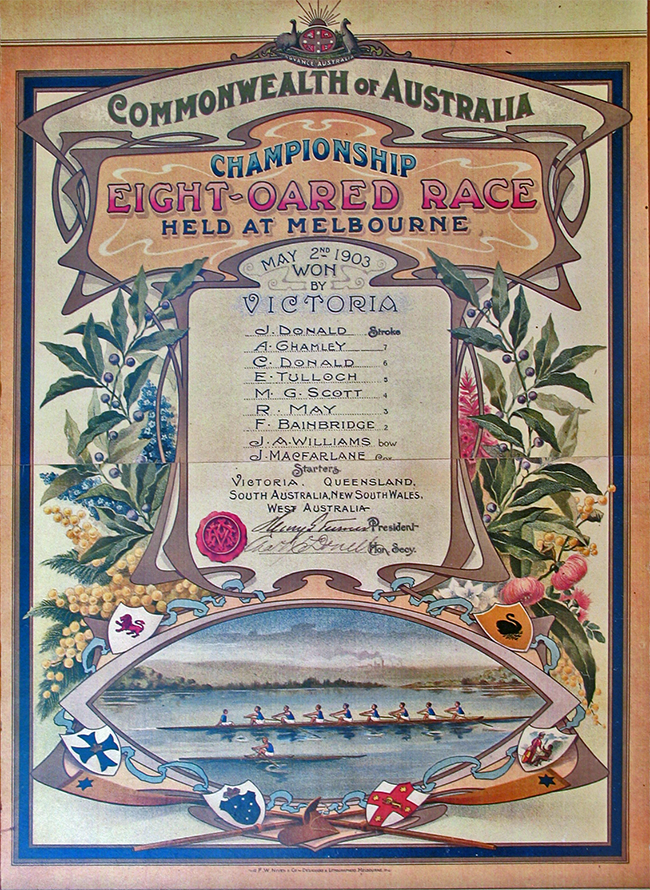
Victoria had two representatives in the sculling championship but without success. The two Mercantile scullers in Percy Ivens and Harold Brash were no match for Bourke of Tasmania who won well.
Victorian Championships
Again the Albert Park Rowing Club dominated taking out the pair, four and eight championships with Percy Ivens of Mercantile winning the sculling championship. These championship wins were added to a good inter club season for Albert Park who also won the club premiership convincingly.
Some extracts from the Victorian Rowing Association annual report.
Spectacular racing was witnessed as the season was formally opened at Footscray in October, when a number of combination eight-oared crews took to the lake and did battle. The high quality of racing observed was indicative of what was to come during the season, at events such as the Upper River Regatta, and the Nagambie, Rutherglen and Seymour Regattas. The Albert Park Rowing Club were victorious in winning the Premiership, as well as the Championship Eight Pennant.
The annual Interstate Eight Race was held on home waters in Melbourne this year, and the Victorian crew extended their unbroken succession of wins in the event to ten, beating the Queensland crew into second place convincingly.
The competitors and visitors in connection with the Interstates Races were entertained at Theatre Parties, Smoke Nights and Dinners all organised by the Victorian Rowing Association. These were well attended and enjoyable for all.
1903-04 season
The 1903-04 rowing season in Victoria was marked by intense intercolonial competition, continued growth at the club level, and increasing enthusiasm for the sport across the state. As the sport entered the new century, Victorian crews remained dominant in national competition, while local regattas showcased a high standard of rowing across senior and junior divisions.
Whilst this season had many highlights, the commencement of the Henley-on Yarra regatta in March 1904 transformed rowing in Victoria and Australia. This regatta was modelled off the Henley Royal Regatta in the UK, complete with magnificent Challenge Cups and an enclosure. There was a gap in both the Australian rowing calendar and the Melbourne sporting calendar in March 1904. Three entrepreneurial rowers, George Fairbairn, Arthur Blackwood and Capt William Rivett, identified the issue and decided to do something about it. An Australian sporting icon event was established with immediate success. A history of this regatta can be found on this website through this link. This regatta immediately became the highlight of the Melbourne sporting scene.
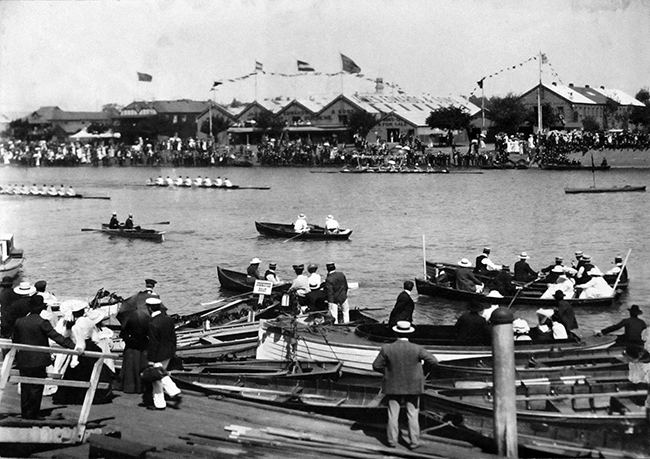
The finishing line
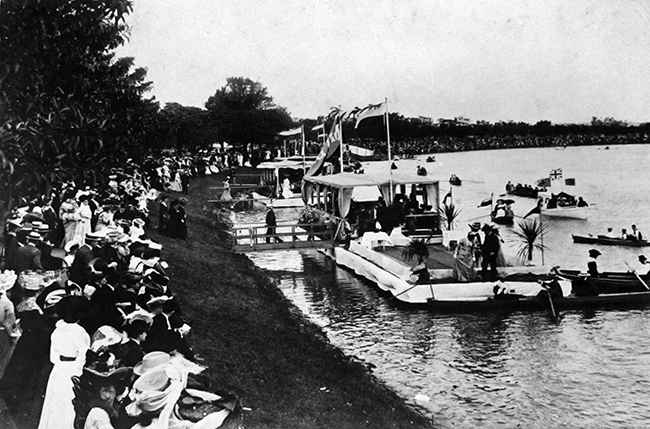
The first house boats at the March regatta which were moored on the north bank - the one in the foreground is from MUBC
Intercolonial Championships
The highlight of the season was Victoria’s impressive performance at the Intercolonial Eight-Oared Championship, held on the Parramatta River in Sydney. The Victorian crew, stroked by James Donald, delivered a commanding performance to secure victory over New South Wales and South Australia. Their win reinforced Victoria’s reputation as the premier rowing state, delivering a superior performance. The race itself was a hard-fought contest, with New South Wales proving to be a formidable challenger. However, the Victorian crew’s higher stroke rate and stronger rhythm saw them pull away in the final stages, crossing the line with a comfortable margin.
In the Intercolonial Sculling Championship, Victoria was also strongly represented, though the title ultimately went to the New South Wales sculler, who demonstrated outstanding endurance and technique in a tightly contested race.
Club Rowing and State Championships
Competition at the club level remained fierce throughout the season, with Victorian clubs continuing to field strong crews across all divisions. The Victorian Eight Oared Championship, a key event in the local rowing calendar, saw a hard-fought battle between Melbourne’s leading clubs, with Banks Rowing Club ultimately claiming victory in a race that showcased the high calibre of Victorian rowing.
Several other key regattas saw intense competition:
- The Henley-on-Yarra Regatta attracted large crowds, bringing a touch of English tradition to Victorian rowing with its emphasis on both competitive and spectacle rowing.
- The Ballarat Regatta remained one of the most prestigious country events, drawing entries from Melbourne-based clubs and strengthening regional rowing competition.
- The Upper Yarra Regatta was once again a highlight for junior and emerging rowers, fostering talent that would later rise to the senior ranks.
Melbourne’s dominant clubs, including Melbourne Rowing Club, Banks Rowing Club, and Yarra Yarra Rowing Club, maintained their fierce rivalries, with well-contested races throughout the season.
School Rowing – Head of the River
The Head of the River regatta continued to grow in prestige, with Melbourne’s top schools—Scotch College, Melbourne Grammar, and Wesley College—producing high-quality crews. The event drew significant public interest, with enthusiastic crowds lining the banks of the Yarra River to watch the next generation of rowers in action. Scotch College emerged victorious in a closely fought race.
Growth and Development of the Sport
The 1903-04 season saw continued growth in rowing’s popularity, with increasing participation at all levels of the sport. Membership in clubs across Victoria continued to rise, and local regattas drew strong support from both competitors and spectators. Equipment and technique were also evolving, with Victorian crews embracing new training methods and refinements in boat design.
With another intercolonial title secured and strong performances across all competitions, the 1903-04 season reaffirmed Victoria’s position at the forefront of Australian rowing.
Some extracts from the Victorian Rowing Association annual report.
Spectators lined the banks of the Yarra and stood atop the Princes Bridge to witness the 1904 season begin with combination eight-oared racing. Sixteen crews competed and put on a spectacle which left rowing enthusiasts and competitors eagerly looking forward to the rest of the season. Regattas such as those held at Nagambie, Footscray, Barwon and Ballarat were highly successful and well contested.
This year the inaugural Henley-on-Yarra was born, and was a fantastic success.
Ballarat Rowing Club were successful in winning the Premiership and the Championship Eight Pennant.
The annual Interstate Eight Race was held at Brisbane in May, and resulted in an eleventh consecutive triumph for the Victorian Crew.
1904-05 season
The 1904-05 rowing season in Victoria was another year of strong performances at both the intercolonial and club levels, with Victorian crews continuing their dominance in national competition. The sport saw further growth, with increased participation across local regattas and a high standard of rowing put on throughout the season.
The Henley regatta moved to its permanent fixture in October and despite poor weather, gained an excellent crowd including the Governor-General, the Governor of Victoria and the Lord Mayor of Melbourne who all occupied house boats.
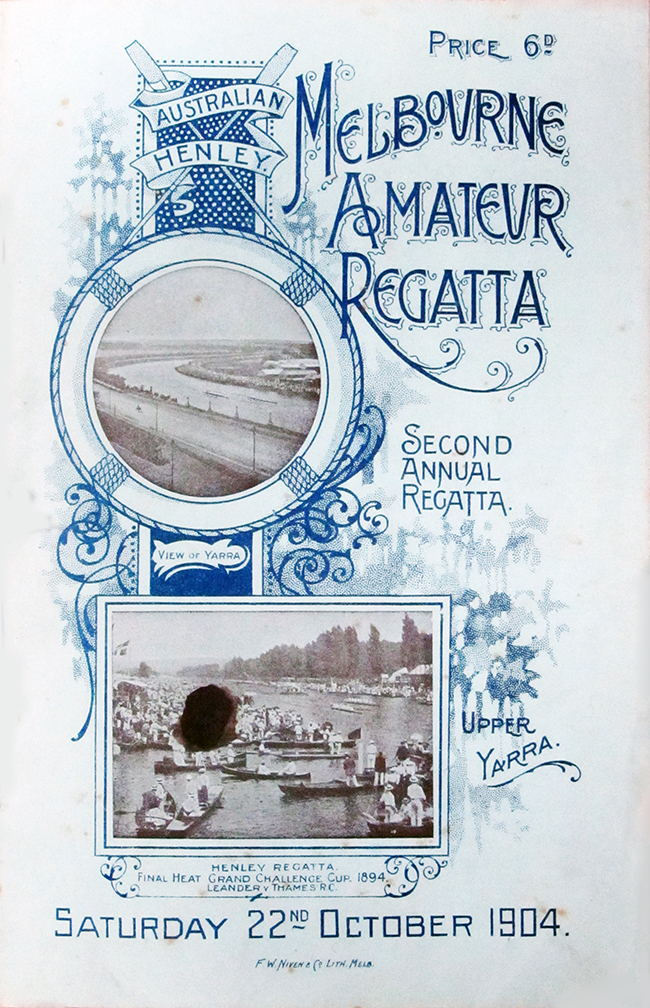
Interstate Championships
The Annual Interstate Eight Race was held on 14 May, 1905, on the Parramatta River in Sydney, marking the significant milestone for the first time all six Australian states were represented in the competition. The Victorian crew, selected by E. R. Ainley, J. M. Macfarlane, and T. Davies, secured their impressive twelfth consecutive victory, defeating Tasmania by a length in a closely contested race. New South Wales finished third, followed by Western Australia, South Australia, and Queensland. The winning time was 16 minutes 25 seconds.
The Victorian crew was as follows: Bow: C. Tulloch, 2: W. Heath, 3: H. Rowe, 4: W. Wright, 5: Henry J. Whiting, 6: Charles Donald, 7: Alex Chamley, Stroke: James Donald, Cox: J. M. Macfarlane.
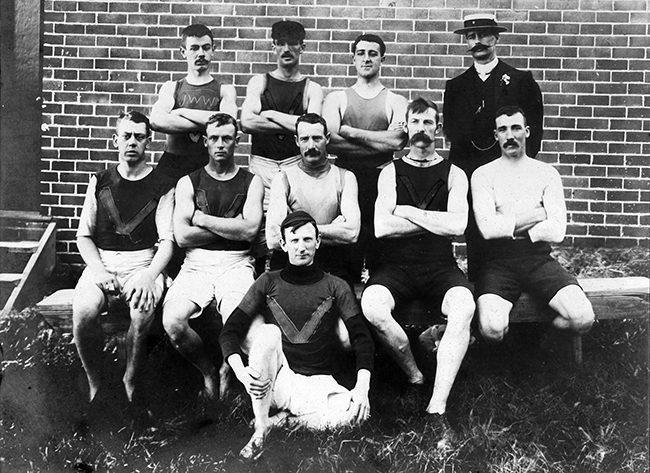
1905 Victorian Eight
Back row: J W Wright, H Rowe, Henry Whiting, T Davies (selector). Front row: C Tulloch, W Heath, James Donald, Alex Chamley, Charles Donald. Front: James M Macfarlane
In the Interstate Sculling Race, held on the same day, Tasmania’s T. H. Bourke claimed victory for the third year in a row, with fellow Tasmanian R. Evans finishing second. Victoria’s Percy C. Ivens placed third, while Western Australia’s H. J. G. Edwards started but withdrew early.
Club Rowing and State Championships
The Victorian Eight-Oared Championship, one of the most anticipated races of the season, featured intense competition among the state’s leading clubs. The Ballarat Rowing Club emerged victorious, showcasing impressive endurance and technical skill.
Other major regattas included:
- The Henley-on-Yarra Regatta, which continued to attract large crowds and elevate the profile of rowing in Melbourne. A crowd of 40,000 attended the regatta which had become a great carnival and a social event of grand proportions. Many houseboats were moored, the fireworks display at night was impressive, there were bands, food sellers, bunting everywhere and spectators from the Botanic Bridge to Princes Bridge. The houseboats were allotted for the Governor-General, The President George Fairbairn, Lachlan Mackinnon of the Melbourne City Council, the Cerberus officers, Australian Club, Melbourne Club, Alexandra Club, Savage Club, MUBC, Miss Simon, and Mrs Mackinnon and finally Mrs William Bates. The festivities all finished at about 9pm with the playing of the national anthem.
- The Ballarat Regatta, which saw strong performances from regional and metropolitan clubs.
- The Upper Yarra Regatta, which provided an opportunity for junior and up-and-coming rowers to compete at a high level.
Melbourne’s dominant clubs—Albert Park, Banks, Mercantile, and Yarra Yarra—continued to battle for supremacy, with several closely contested races throughout the season.
School Rowing – Head of the River
The Head of the River regatta once again showcased Victoria’s finest schoolboy rowers, with Scotch College, Melbourne Grammar, and Wesley College leading the charge. The event drew large crowds along the Yarra River, reinforcing its status as a major fixture in the school sporting calendar. Wesley College managed to nudge out Melbourne Grammar for line honours by a canvas.
Some extracts from the Victorian Rowing Association annual report.
Albert Park was the arena where Combination Eight-Oared Races marked the opening of the 1905 season, in which 13 crews competed for glory. This event was to kick off an entertaining and engaging rowing season for oarsmen, spectators and the rest of the Victorian Rowing Association. The Albert Park Rowing Club were the most consistent performers at the season’s multitude of regattas, and hence were awarded the Premiership for the year. The Ballarat Rowing Club would claim the Championship Eight Pennant.
Victoria could enjoy success at the Interstate Races, which were held at Sydney on the Parramatta River in May. All six states were present and witnessed a tremendous showdown between Victoria and Tasmania, which the Victorian Crew would ultimately win by a length. Unfortunately, the winning form could not be replicated by P C Ivens who finished third in the Sculling race.
1905-06 season
The 1905-06 rowing season in Victoria was another thrilling chapter in the state’s rich rowing history, with continued intercolonial success, fierce club competition, and an ever-growing interest in the sport. As rowing in Australia matured, Victorian crews remained at the forefront, demonstrating remarkable consistency and skill across all levels of competition.
Interstate Championships
The Interstate Eight-Oared Championship took place on Sydney’s Parramatta River on 12 May 1906, attracting strong crews from all six Australian states. Victoria entered the regatta as the undisputed powerhouse of Australian rowing, having won the previous twelve consecutive titles. Under the guidance of selectors E. R. Ainley, J. M. Macfarlane, and T. Davies, the Victorian crew delivered yet another resounding victory, this time defeating New South Wales by over a length. Tasmania finished third, followed by Queensland, Western Australia, and South Australia.
The winning time of 16 minutes 18 seconds underscored the crew’s technical proficiency and superior conditioning. The Victorian lineup was as follows: Bow: C. Tulloch, 2: W. Heath, 3: H. Rowe, 4: W. Wright, 5: Henry J. Whiting, 6: Charles Donald, 7: Alex Chamley, Stroke: James Donald, Cox: James M. Macfarlane.
The Interstate Sculling Championship, held on the same day, saw T. H. Bourke of Tasmania continue his dominance, claiming his fourth consecutive title. His compatriot R. Evans secured second place, while Victoria’s Percy C. Ivens finished third in what was a highly competitive field.
Club Rowing and State Championships
At the club level, the Victorian Eight-Oared Championship once again provided a thrilling spectacle, with Albert Park Rowing Club taking home the prestigious title after a well-executed race strategy.
In addition to the usual large regattas of the Ballarat Regatta and the Henley-On-Yarra Regatta, the Barwon Regatta was also a great success. It provided more opportunity for rising talents to emerge from Geelong-based crews. The Henley regatta continued to grow in popularity with the Melbourne public and it was now the major social event of the year. The regatta committee decided to fund Victorian crews competing at the Interstate Championships thus solving one of the Association's ongoing financial issues.
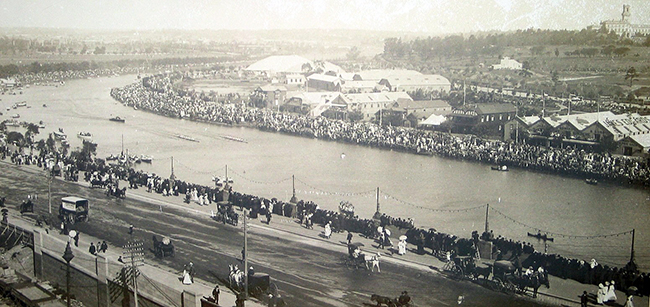
Finish of the Australian Henley Regatta in 1906 before the course was moved further upstream
Competition between Melbourne’s leading rowing clubs—Banks, Mercantile, Yarra Yarra, and Albert Park—was particularly fierce, with races often decided by the slimmest of margins. The growing depth of talent within these clubs ensured that Victorian rowing remained at an exceptionally high standard.
School Rowing – Head of the River
The Head of the River regatta maintained its reputation as the pinnacle of school rowing, with Scotch College, Melbourne Grammar, and Wesley College once again fielding the standout crews. The final saw Scotch College emerge victorious, overturning their result from the previous season when they fell behind Wesley by a bare margin. The enthusiasm surrounding school rowing continued to strengthen, continuing to provide a steady pipeline of future champions for Victorian clubs.
Some extracts from the Victorian Rowing Association annual report.
Rowing enthusiasts and admirers of sporting competitions lined along the Princes Bridge in October, where eight-oared combination races marked the formal opening of the season on the Yarra. A record number of entries for this class was received, with no fewer than 25 crews competing. The winning crew was made up of athletes from the Hawthorn, Albert Park, Essendon, Mercantile, South Melbourne and Yarra Yarra Rowing Clubs.
For the first time in the history of the Interstate Eight-Oared Championship of Australia, the race was rowed on the Swan River in Perth, Western Australia. With the exception of Queensland, all states of the Commonwealth would contest the competition. The Tasmanian crew retrieved their defeat from Sydney in the previous iteration and laid down a Herculean performance to see off the Victorian Crew by half a length. The Tasmanian representee in turn, would lose by some twenty lengths to the Victorian Sculler, P C Ivens of Mercantile Rowing Club, in the Interstate Sculling Race.
Domestically, Albert Park Rowing Club were untroubled in their quest to win the Premiership, performing exceedingly well with great consistency in the many regattas throughout the season.
In an interview in Western Australia in 1906, the highly regarded boatbuilder and coach Syd Edwards was asked why Victorian rowing was so successful. His answer has some historical interest as he highlights that in the early days of rowing in New South Wales, used whale boats rather than racing boats. Thus Victoria had a good start on NSW. He then went on to say that the still water in Melbourne enabled rowers to row better and throughout the year. Thia natural advantage was in his view important. Finally, he highlighted that rowers were within an easy walk from the city, and further, there were many boathouses in the same area on the Yarra River. This kept the interest in the sport at a higher level than elsewhere. These natural advantages were regarded as significant and he highlighted that the differences in personnel were not an issue.
1906-07 season
The 1906–07 season marked a pivotal year in Victorian rowing, with strong competition, memorable performances, and a deep sense of both celebration and loss reverberating throughout the rowing community. It was a season defined by dominant clubs, standout athletes, logistical advancements, and poignant tragedy. 1907 was also the year in which the Albert Park Ladies Rowing Club was formed, the first solely women's rowing club in Victoria. This initiative was led by Cassie Wooley.
Opening of the Season
The official opening of the rowing season took place on the Upper Yarra on Saturday, 6 October 1906. As was tradition, the day featured combination eights, with 128 entries forming 16 crews. The winning combination was a mixed assembly of oarsmen from several prominent clubs; Harold Brasch (Mercantile) stroked the crew, followed by D. Cameron (Mercantile), R.G. Ball (Banks), F. Grinter (Albert Park), P.C. Dowling (Ballarat), D. Power (University), R. Cook (Banks), and E.F. Wilkinson (Ballarat) in the bow seat.
The Australian Henley regatta continued to be a huge success. A lower number of rowing entries did nothing to stop this regatta, or perhaps better described as carnival, thriving. The success caused mutterings that the Melbourne City Council should share in the financial rewards of the carnival and one newspaper article goes onto to emphatically call for them to keep their hands off the event. The argument concluded with: Instead, the City Corporation should realise what it will do towards making Melbourne the capital of Australia in the full sense of the term, and assist the promoters heartily to make it more successful every year. As an aside, it is recorded in the Regatta Committee minutes that the Council wanted 50% of the profits of the regatta.
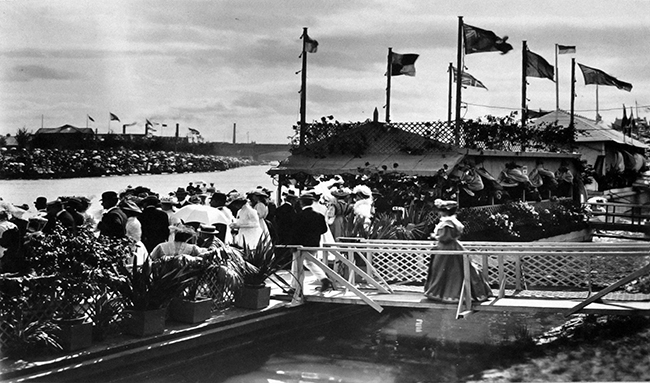
The Alexandra Club houseboat at 1907 Henley regatta
Interstate Eight-Oared Championship
In what was a significant moment for South Australian rowing, the 31st annual Interstate Eight-Oared Championship was held in Adelaide—the first time the race was hosted in South Australia. Victoria fielded a powerhouse crew and clinched their 25th victory in 31 editions of the race. Coached by the esteemed J.H. Macfarlane, the crew included: Cox: B. Arnold, Stroke: James Donald, 7: M. Scott, 6: A. Purvis, 5: Henry J. Whiting, 4: H.G. Ferguson, 3: V. H. Gard, 2: E. James, Bow: C.B. Whiteside.
Their win was a testament to Victoria’s continuing dominance on the national stage.
Interstate Sculling Championship
Once again, Victoria's Percy C. Ivens (Mercantile) proved himself a master of the sculling discipline, capturing his sixth successive national title in the Interstate Sculling Championship. Ivens completed the 3-mile, 720-yard course in 23 minutes and 54.4 seconds. His nearest rival, D. Green of New South Wales, was followed by Tasmania’s E. Jack and Western Australia’s J. Hill.
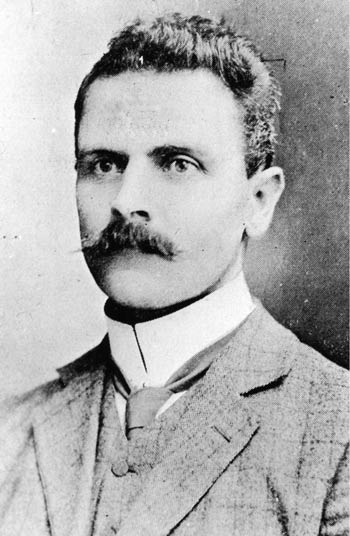
Percy Ivens
Championship Events
Champion Eight-Oared Race: Held on 23 March 1907 on the Lower Yarra, the race saw Albert Park claim victory in a record time of 12 minutes 20.2 seconds, with Banks second and Mercantile third. The winning crew featured a strong combination including James Donald (stroke), M. Scott, C. Donald, H.J. Whiting, C.H. Kohn, W. Low, J.R. Corteen, H. Green, and coxswain B. Arnold.
Champion Four-Oared Race: Conducted on 17 November 1906, this race was won by Mercantile No. 1, comprising A.B. Sloan (stroke), H. Lindgren, W. Potter, and P.C. Ivens, with A. Wickham coxing. Albert Park placed second, ahead of Hawthorn and Mercantile No. 2.
Champion Pair-Oared Race: Postponed due to the tragic drowning incident of Albert Hoof of Mercantile, the race was moved from 1 December, 1906 on 19 January, 1907. Mercantile again emerged victorious, with J.J. Fogarty (stroke), H. Lindgren (bow), and A. Wickham (cox). They defeated crews from South Melbourne, Banks, Albert Park, and Hawthorn.
Champion Sculls: P.C. Ivens further solidified his sculling legacy by winning in 16 minutes and 21 seconds. His only opponent, H. Allatt, also hailed from Mercantile.
Premiership Standings
A significant innovation this season was the introduction of two separate premierships—Senior and Junior. Albert Park Rowing Club claimed both, reflecting their comprehensive strength across all levels of competition.
Senior Premiership:
- Albert Park – 78 points
- Mercantile – 66
- Wendouree – 50
Junior Premiership:
- Albert Park – 36 points
- Corio Bay – 16
- Mercantile – 7
Regattas and Events
The season was bolstered by an array of regattas across Victoria, including Henley-on-Yarra, Seymour, Nagambie, Colac, Footscray, Upper Yarra, Ballarat, Barwon, Bairnsdale, and Paynesville. The Annual Regatta held on 15 December 1906 on the Upper Yarra was a standout success, with competitive fields across all classes.
Innovations and Administration
In a progressive move, the Association purchased a new best eight-oared shell for use by the representative crew—an investment into future success. Meetings of the Association also found a new home at the Amateur Sports Club, thanks to its generous provision of meeting space. The creation of a noticeboard for regatta information further improved communication among clubs.
Thirteen committee meetings were held throughout the year, with active participation from members and representatives of affiliated clubs.
Obituaries
The season was sadly overshadowed by the tragic death of Mr. Albert E. Hoof during the attempted Champion Pair-Oared Race. A dedicated member of the Mercantile Rowing Club and the Association, Mr. Hoof’s passing was deeply felt. Also mourned was Mr. A. Nicholls, a respected oarsman of earlier years whose contributions to rowing were fondly remembered.
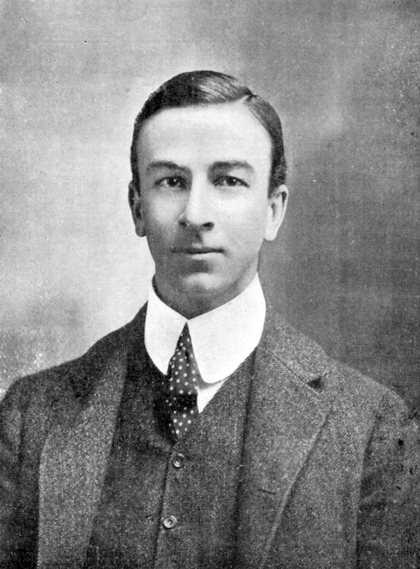
Albert Hoof
Some extracts from the Victorian Rowing Association annual report.
The traditional season opening took place on the Upper Yarra in October, with the spectacle of combination Eight-Oared Racing. 128 athletes made up a total of 16 crews, and what followed was a tremendously enjoyable afternoon’s racing. Albert Park Rowing Club were dominant across many classes of racing at the superbly organised Henley-on-Yarra, Seymour, Nagambie and Bairnsdale regattas amongst others, and were rewarded for their efforts with the Senior and Junior Premierships.
The 31st Annual Interstate Eight-Oared Race was held in South Australia for the second time, and all states of the Commonwealth were represented. Victoria achieved the unprecedented feat of winning the competition for the 25th time out of 31 racing occasion since its inception in 1878. On the same day in Adelaide, the Interstate Sculling Championship was held, and resulted in a spectacular win for P C Ivens of Mercantile Rowing Club.
During the season, the committee of the Victorian Rowing Association made the justifiable decision of purchasing a best eight for the use of future crews representing the state in the Annual Interstate Contest.
1907-08 season
The 1907–08 rowing season in Victoria commenced on 12 October 1907 with the Champion Sculls, which was designated the official opening of the season in place of the usual combination eight-oared races. This change was made due to a scheduling conflict with multiple clubs holding their own events on the traditional opening day. The Annual Regatta was held on the Upper Yarra on 14 December 1907 and was considered a success. A strong regatta calendar also featured races at Henley-on-Yarra, Seymour, Nagambie, Colac, Upper Yarra, Footscray, Ballarat, Barwon, Bairnsdale and Paynesville.
The Henley regatta changed course this year to the current Henley mile course. The Argus correspondent also concluded: The transfer of the Henley reserve from the north to the south bank was a distinct improvement. Last year spectators had to promenade on a narrow, uneven slope along the north bank, but on Saturday the tastefully-designed reserve alongside Alexandra-parade provided ample accommodation and an excellent view of the races. The reserve, which was temporarily fenced for the occasion, was laid out by Mr. Catani, of the Public Works department. Its walks and lawns and general scheme at once suggest the hand of an artist. It also enabled crews to have a far fairer course with most of it straight. The Henley carnival concluded as usual with an evening program of music, lighting and fireworks, all of which were again popular with tens of thousands of spectators.
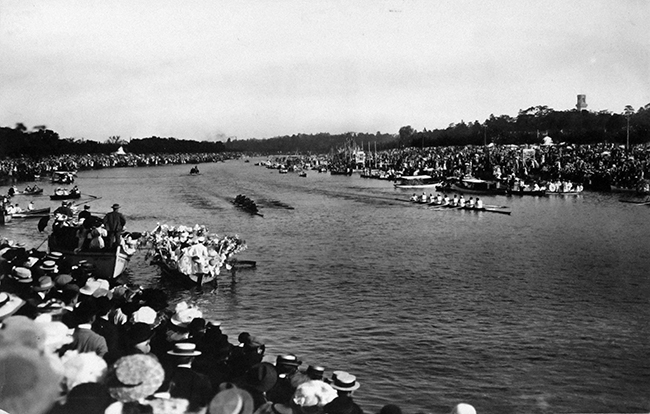
Mercantile narrowly defeating Albert Park in the Grand at Henley
The Interstate Regatta
The Interstate Eight-Oared Championship of Australia was contested on the Yarra River on 9 May, 1908. In a closely contested race, New South Wales emerged victorious, with Victoria finishing second, ahead of Tasmania, South Australia, Western Australia and Queensland. The Victorian crew comprised: Cox: B. Arnold, Stroke: James Donald, 7. M. G. Scott, 6. Charles Donald, 5. Henry J. Whiting, 4. P. McNaughton, 3. V. Gard, 2. William Potter, Bow: G. Ferguson. W. J. Middleton was coach and P. D. Kilby was the manager. The New South Wales crew's win was noted as being especially popular and well deserved.
The Interstate Sculling Championship was also held on the same day. Victoria’s official representative, Percy C. Ivens, withdrew due to illness, though permission was granted for Harold Brasch, also of Victoria, to compete as an additional entrant. Brasch performed admirably, finishing second to Tasmania’s Edwin Jack, although a dispute concerning Jack’s eligibility was still under review at season’s end. [As described below, subsequently Brasch was awarded the race as Jack failed the amateur status rule.] J. R. Towns (New South Wales) and W. M. Callaghan (Queensland) finished third and fourth respectively.
An Interstate Rowing Conference was held while all states were represented in Melbourne. The conference resolved to standardise future championship courses:
Victoria: Yarra River
New South Wales: Paramatta River
Queensland: Brisbane River
Western Australia: Swan River
South Australia: Port Adelaide River
It was also agreed that future entries to interstate events would require a declaration of eligibility in line with the 1896 amateur definition. In Tasmania, a test race between rival rowing bodies led to the Launceston-based Tasmanian Rowing Association being recognised for the 1908 championship crew.
Local regattas
Locally, the Victorian Champion Sculls were held on 12 October 1907 and resulted in a row-over for Percy C. Ivens (Mercantile), who secured his seventh consecutive title. The Champion Four-Oared Race was held on 16 November 1907 and won by Albert Park. The Champion Pair-Oared Race, contested on 30 November 1907 over a mile course from the canal entrance to Footscray, produced an exciting finish, with Essendon’s crew of D. McNaughton (stroke), E. Wight (bow), and W. Reidy (cox) defeating Civil Service by just one foot. Albert Park finished third in that event. The Champion Eight-Oared Race was held on 21 March 1908 on the Lower Yarra. Although Albert Park crossed the line first, they were disqualified for breaching course regulations by passing inside a beacon at Coode Island. The victory was therefore awarded to the Mercantile Rowing Club crew.
The season also marked the second year of separate premierships for senior and junior competition. Mercantile secured the Senior Premiership, while Footscray City claimed the Junior Premiership. The Junior points table reflected the intensity of competition in maiden and junior events, with Footscray scoring 72 points, well ahead of Mercantile (49), Ballarat (42), and Wendouree (36). In the senior standings, Mercantile topped the list with 56 points, followed by Albert Park with 28, Essendon with 22, and Ballarat with 6. The introduction of separate premierships, implemented the previous season, was seen as a successful initiative by the Association.
The committee placed on record its appreciation for the work of outgoing Honorary Secretary James Forsyth, who had served in that role throughout a particularly demanding year. The Association also acknowledged with regret the passing of Mr. Eric R. Ainley, a Vice-President and former champion oarsman who was, at the time of his death, President of the Yarra Yarra Rowing Club.
Throughout the season, the sport was well supported by affiliated clubs, which included Albert Park, City, Bairnsdale, Banks, Civil Service, Essendon, Footscray City, Hawthorn, Mercantile, Nagambie, Richmond, Seymour, South Melbourne, Sandhurst, Wendouree, Yarra Yarra, University, Cobram, Old Wesley Collegians, Colac, Corio, Yarrawonga, Sale and Shepparton. The season also saw strong financial backing, especially from those who donated to the costs associated with hosting the Interstate contests and the Ships’ Gigs races held at the Annual Regatta.
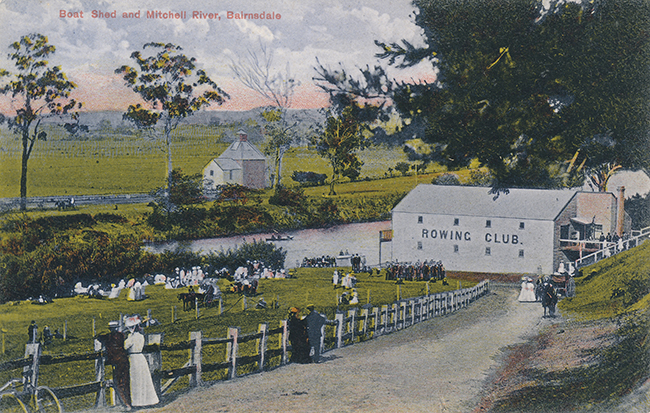
Postcard of Bairnsdale Rowing Club on the Mitchell River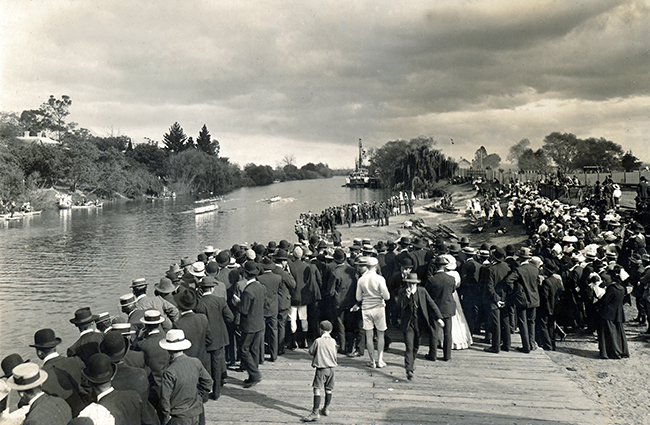
Regatta day in 1908 at Bairnsdale with South Melbourne defeating Mercantile in the maiden eights
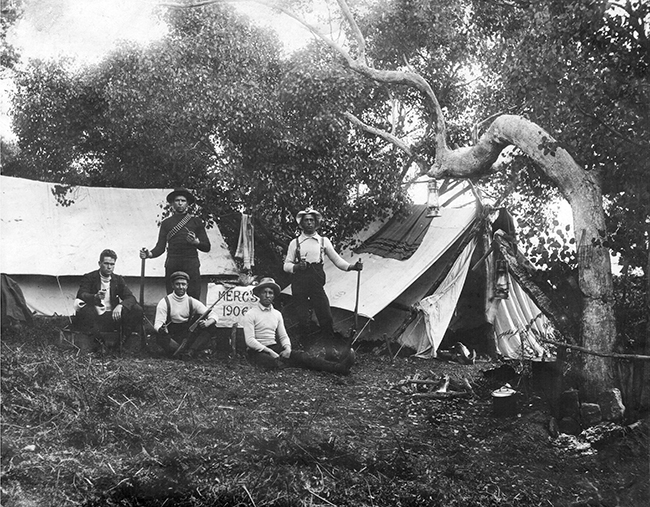
Many clubs competing at Bairnsdale took the opportunity to go camping over the weekend. Here is Mercantile in 1906 who clearly intended to live off the land hunting.
Finally, thanks were extended to various volunteers and officials, including starters, umpires, judges and timekeepers, as well as the Amateur Sports Club for hosting committee meetings, and the press for their ongoing support of the sport. The season closed with renewed confidence in the strength and integrity of amateur rowing in Victoria.
Some extracts from the Victorian Rowing Association annual report.
In light of the fact that many clubs were holding eight-oared races on the date which was usually selected to commence the opening of the season, it was decided that the Champions Sculls would be the most suitable occasion on which to kick the season off in October.
The 32nd Annual Interstate Eight-Oared Championship of Australia was rowed in Melbourne on the River Yarra in May, and resulted in a thoroughly deserved win for the strong willed crew from New South Wales, Victoria had once again to be satisfied with a second place finish, made easier in light of New South Wales’s tremendous ability. P C Ivens, the elected athlete for the Interstate Sculling Race, to be held on the same day, was unable to compete in the race owing to indisposition, however his clubmate, H Brasch, received permission to act as a second Victorian Representative, and duly rowed a fine race to finish in second place behind the Tasmanian Sculler.
The Henley Regatta Committee, Albert Park Rowing Club and the Metropolitan Fire Brigades’ Board showed the highest level of hospitality to the visiting state crews.
Mercantile Rowing Club proved victorious in the fiercely contested Senior Premiership, following consistently competitive displays at the likes of Henley-on-Yarra, Nagambie, Colac and the Annual Regatta. Footscray City Rowing Club claimed the Junior Premiership.
1908-09 season
The 1908–09 season was one of record-breaking participation and continued enthusiasm for the sport in Victoria. The season officially commenced on 12 October 1908 with the Championship Sculling Race on the Lower Yarra.
The Australian Henley regatta continued to grow with spectator number rising to over 60,000during the day and even more in the evening. The regatta committee was now becoming a major supporter of visiting crews and donor to various causes. It also continued to contribute to river bank enhancements. The regatta paid for the Henley Staging on the south bank, the pathway along both sides of the Yarra River and the landscaping of Alexandra Gardens.
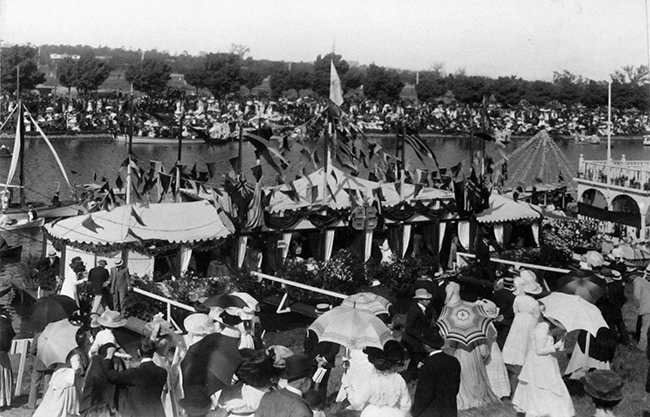
The Lord Mayor and Lady Mayoress' house boat in 1909
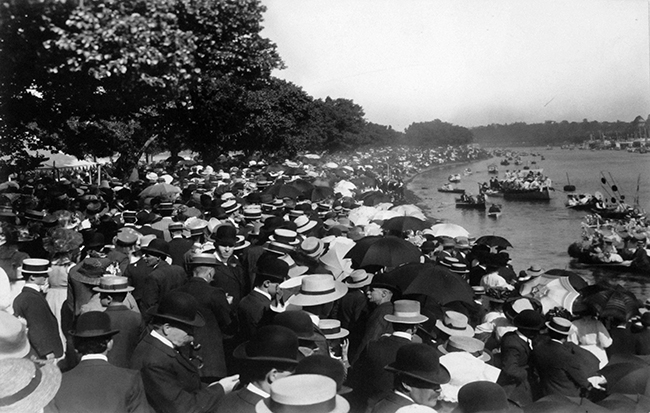
The north bank
Interstate Championships
Victoria competed at the Interstate Eight-Oared Championship held on the Brisbane River on 15 May 1909, finishing second behind Tasmania in a closely contested event. New South Wales placed third and Queensland fourth, while South Australia and Western Australia did not field crews. The Victorian crew, coached by C. Donald and C.E. Kellett in Melbourne, and assisted in Brisbane by George E. Upward, included W.L.B. Mitchell, F. Johnson, C.H. Bolger, G.R. James, J.J. Fogarty, V. Gold, D. Carmichael, and G. Hodgson, with L. McLintock as coxswain. J.W. Wright served as emergency. Despite their best efforts, the Association acknowledged that greater performance would be needed to reclaim the national title in future years.
In the Interstate Sculling Championship, held on the same day, New South Wales’ J.R. Towns claimed a convincing victory. Victoria’s representative, A. Richards, finished fourth after drawing the outside station and struggling in rough conditions. Towns’ win marked the third consecutive sculling title for New South Wales.
The Association also revisited the 1908 Interstate Sculling Race, officially declaring Harold Brasch of Victoria as the winner following the disqualification of Edwin Jack (Tasmania), whose title was withheld pending approval from other states. All but Tasmania supported Victoria’s appeal.
Local racing
Locally, A. Richards of South Melbourne Rowing Club won the Champion Sculls on 10 October 1908, defeating Harold Brasch of Mercantile. This was the first time the South Melbourne Club had secured this prestigious event.
The Champion Four-Oared Race, held on 28 November 1908, attracted five entries—the largest field since 1890—and was won in record time by Nagambie. The successful crew featured Mr. Heath (stroke), F. Catlin (3), T. Vickers (2), R. Welch (bow), and D.C. Carter (cox). Footscray City finished second, followed by Mercantile, Albert Park, and Civil Service.
The Champion Pair-Oared Race was contested on 16 January 1909 over a shortened course from the “Tunnel” due to high entries. Despite rough conditions, Civil Service rowed to a clear win over Albert Park and Nagambie.
A record number of six crews contested the Champion Eight-Oared Race on 20 March 1909, which was rowed on the Yarra with special permission to finish at the Gridiron. In front of a large crowd, Albert Park emerged victorious with a polished performance. Their crew—C. Donald, R.G. Scott, C.H. Bolger, F. Johnson, D. O’Meagher, L. Johnston, W. Wells, J.W. Wright, and cox H. Arnold—finished ahead of Footscray City, Nagambie, Mercantile, Yarra Yarra, and Banks. The win was widely celebrated as one of the best in Albert Park’s history.
The Annual Regatta, held on 12 December 1908 on the Upper Yarra, featured a full card of events across maiden, junior, and senior classes. Mercantile, Wendouree, Yarra Yarra, Albert Park, Civil Service, and Footscray City were among the successful clubs. The regatta was a significant highlight of the season, capped off by strong entries and well-contested racing.
Numerous regional regattas were held throughout the season in Bairnsdale, Sale, Nagambie, Colac, Barwon, Ballarat, Footscray, and Seymour. School, university, and inter-collegiate races also continued to flourish, alongside the now-traditional Warehousemen’s and Military Eight-oared contests.
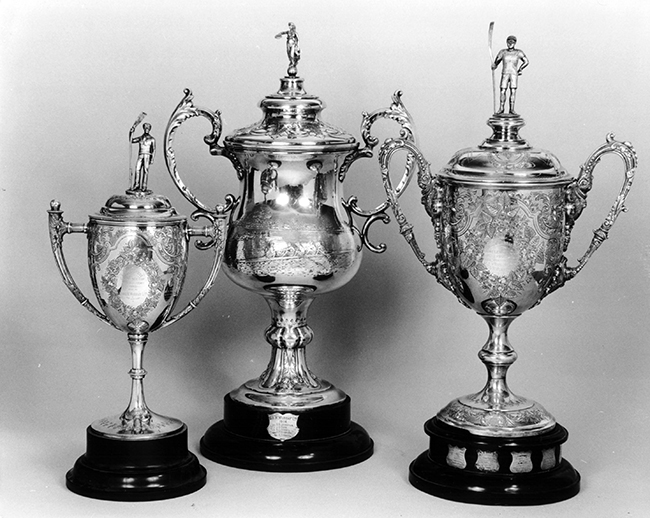
The Warehousemen's Challenge Trophies donated by various merchants of Melbourne
In the premiership competitions, Albert Park retained the Senior Premiership, while South Melbourne secured the Junior title after a closely run contest that was only decided at the final regatta in Sale. This marked a particularly strong showing from South Melbourne, confirming their emerging presence in the junior ranks.
Administration
The Association recorded the passing of Vice-President Thomas Ellison during the year and extended its sympathies to his family. The finances of the Association remained sound, despite the increased cost of the Brisbane trip. The balance sheet was bolstered by generous donations from members and shipping companies, and administrative expenses were kept in check.
A presentation was made to the long-serving President Henry Gyles Turner, commemorating his 25 years of leadership with a framed portrait of the 1907–08 Committee and Office-Bearers. The season also saw the adoption of new bye-laws regarding regatta entries and administrative formalities.
Importantly, a bill regulating river traffic on the Upper Yarra was passed through Parliament and would now be administered by the Ports and Harbours Department. The Association supported this development, which would help safeguard rowing activities on the busy waterway.
At season’s end, both J.W. Hamilton (Hon. Treasurer) and W.T. Wilkinson (Hon. Secretary) stepped down from their roles, having served the Association with distinction. Their contributions were warmly acknowledged.
Some extracts from the Victorian Rowing Association annual report.
The official opening of the season was celebrated with the Championship Sculling Race in October, to commence what was a busy and successful season for the Victorian Rowing Association and it’s members. Regattas such as Henley-on-Yarra, Seymour, Colac and Footscray were capably and successfully carried out. The conclusion of the domestic racing season saw Albert Park secure the Senior Premiership, whilst South Melbourne were successful in attaining the Junior Premiership.
Tasmania were the winners of the coveted Australian Eight-Oared Championships, which was contested on the Hamilton Reach, Brisbane, with the Victorian Crew in second place following a hearty performance.
In a sadder development, Victorian oarsmen mourned the loss of Vice-President, Mr Thomas Ellison. During the year a presentation of a large framed group of the Committee and Office-Bearers of the 1908 season was made to the esteemed president of the Victorian Rowing Association, Mr Henry Gyles Turner, to mark the record of an incredible 25 years of Presidentship.
In other news, a Bill was passed through both Houses of Parliament for the regulation of traffic on the Upper Yarra, this Act would be administered by the Ports and Harbours Department.
Footnotes
Most references in this chapter come from the annual reports of the Association which can be found in Appendix 16.
1. AN AQUATIC CARNIVAL. (1901, May 9). The Age (Melbourne, Vic. : 1854 - 1954), p. 6. Retrieved April 5, 2025, from http://nla.gov.au/nla.news-article190043321
2.
< previous Chapter 4
> next Chapter 6

